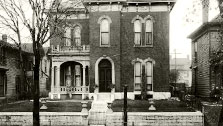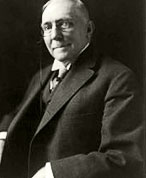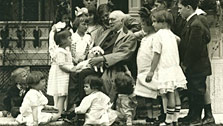
James Whitcomb Riley
By the 1870’s the demand for and construction of small cottages for artisans and workers began to fall off, but the market for mansions grew stronger, including one that would turn out to be, and remain, the single most important building in the neighborhood. John H. Nickum, a prosperous cracker baker, and his wife and their daughter Magdalena and her husband, Major Charles Holstein, moved into their stylish Italianate home at 528 Lockerbie St. in 1873. Other prominent families, the Cobbs and the Igoes, occupied similar houses on the same block, all surrounded by leafy trees and gas lamps.


The Holsteins had a frequent visitor, James Whitcomb Riley, the much revered “Hoosier Poet” and celebrated raconteur, who was then living a decidedly Bohemian life in a boarding house on Pennsylvania St. (insert Riley photo here) He enjoyed the neighborhood, the house, and its occupants so much that he eventually (in 1893) moved in as a boarder. He stayed for twenty three years. Here is his tribute to the place.
“Lockerbie Street”
Such a dear little street it is, nestled away From the noise of the city and the heat of the day In cool shady coverts of whispering trees. With their leaves lifted up to shake hands with the breeze Which in all its wide wanderings never may meet With a resting-place fairer than Lockerbie Street! There is such a relief from the clangor and din Of the heart of the town, to go loitering in Through the dim, narrow walks, with the sheltering shade Of the trees waving over the long promenade. And littering lightly the ways of our feet With the fold of the sunshine down Lockerbie Street And the nights that come down the dark pathways of dusk. With the stars in their tresses, and odors of musk In their moon-woven raiments, bespangled with dews. And looped up with the lilies for lovers to use In the songs that they sing to the tinkle and beat Of their sweet serenadings through Lockerbie Street. O my Lockerbie Street! You are fair to be seen Be it noon of the day, or the rare and serene Afternoon of the night--you are one to my heart. And I love you above all the phrases of art. For no language could frame and no lips could repeat My rhyme-haunted raptures of Lockerbie Street.

Riley’s long and happy residence in the Nickum/Holstein home brought many distinguished guests and numerous admirers to the neighborhood conferring on it some of the luster of his celebrity. Shortly after his death in that house (July 22, 1916), and the death of Magdalena Holstein the same year, a group of Riley’s distinguished and prosperous friends, Booth Tarkington, Meredith Nicholson, George Ade, and others, purchased the land and, in 1921, founded the James Whitcomb Riley Memorial Association to establish a museum honoring the poet. The purchase of all the “household goods” from the home’s housekeeper, to whom Magdalena Holstein had bequeathed them, enabled the mansion to remain as splendidly Victorian as the poet had known it. The “James Whitcomb Riley National Shrine” opened in 1923, serving as a landmark and a foundation for the neighborhood through the grim years that were about to fall upon it.
